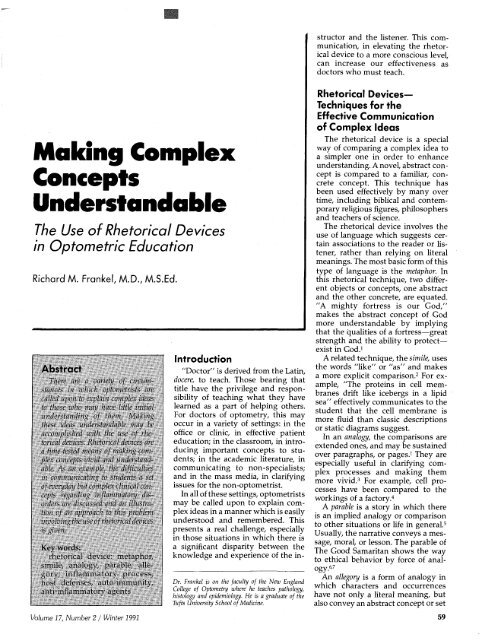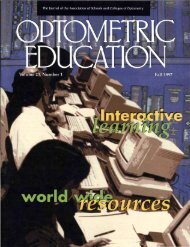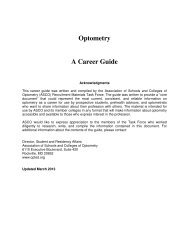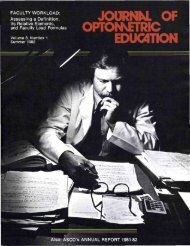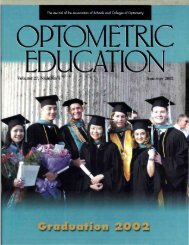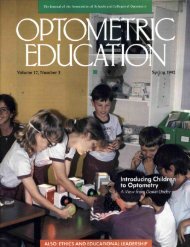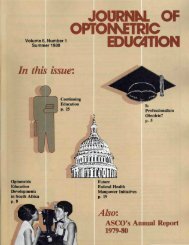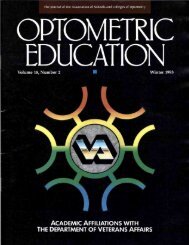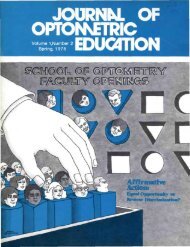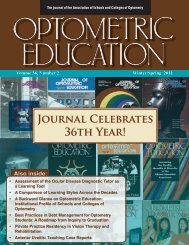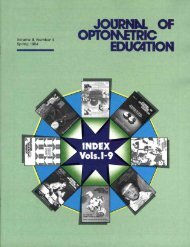Winter 1992, Volume 17, Number 2 - Association of Schools and ...
Winter 1992, Volume 17, Number 2 - Association of Schools and ...
Winter 1992, Volume 17, Number 2 - Association of Schools and ...
You also want an ePaper? Increase the reach of your titles
YUMPU automatically turns print PDFs into web optimized ePapers that Google loves.
Making Complex<br />
Concepts<br />
Underst<strong>and</strong>able<br />
The Use <strong>of</strong> Rhetorical Devices<br />
in Optometric Education<br />
Richard M. Frankel, M.D., M.S.Ed.<br />
Abstract<br />
There are a variety <strong>of</strong> circumstances<br />
in which optometrists are<br />
called upon to explain complex ideas<br />
to those who may have little initial<br />
underst<strong>and</strong>ing <strong>of</strong> them. Making<br />
these ideas underst<strong>and</strong>able may be<br />
accomplished with the use <strong>of</strong> rhetorical<br />
devices. Rhetorical devices are<br />
a time-tested means <strong>of</strong> making complex<br />
concepts vivid <strong>and</strong> underst<strong>and</strong>able.<br />
As an example, the difficulties<br />
in communicating to students a set<br />
<strong>of</strong> everyday but complex clinical concepts<br />
regarding inflammatory disorders<br />
are discussed <strong>and</strong> an illustration<br />
<strong>of</strong> an approach to this problem<br />
involving the use <strong>of</strong> rhetorical devices<br />
Key words:<br />
rhetorical device: metaphor,<br />
simile, analogy, parable, allegory;<br />
inflammatory process,<br />
host defenses, auto-immunity,<br />
anti-inflammatory agents<br />
Introduction<br />
"Doctor" is derived from the Latin,<br />
docere, to teach. Those bearing that<br />
title have the privilege <strong>and</strong> responsibility<br />
<strong>of</strong> teaching what they have<br />
learned as a part <strong>of</strong> helping others.<br />
For doctors <strong>of</strong> optometry, this may<br />
occur in a variety <strong>of</strong> settings: in the<br />
<strong>of</strong>fice or clinic, in effective patient<br />
education; in the classroom, in introducing<br />
important concepts to students;<br />
in the academic literature, in<br />
communicating to non-specialists;<br />
<strong>and</strong> in the mass media, in clarifying<br />
issues for the non-optometrist.<br />
In all <strong>of</strong> these settings, optometrists<br />
may be called upon to explain complex<br />
ideas in a manner which is easily<br />
understood <strong>and</strong> remembered. This<br />
presents a real challenge, especially<br />
in those situations in which there is<br />
a significant disparity between the<br />
knowledge <strong>and</strong> experience <strong>of</strong> the in-<br />
Dr. Frankel is on the faculty <strong>of</strong> the New Engl<strong>and</strong><br />
College <strong>of</strong> Optometry where he teaches pathology,<br />
histology <strong>and</strong> epidemiology. He is a graduate <strong>of</strong> the<br />
Tufts University School <strong>of</strong> Medicine.<br />
structor <strong>and</strong> the listener. This communication,<br />
in elevating the rhetorical<br />
device to a more conscious level,<br />
can increase our effectiveness as<br />
doctors who must teach.<br />
Rhetorical Devices-<br />
Techniques for the<br />
Effective Communication<br />
<strong>of</strong> Complex Ideas<br />
The rhetorical device is a special<br />
way <strong>of</strong> comparing a complex idea to<br />
a simpler one in order to enhance<br />
underst<strong>and</strong>ing. A novel, abstract concept<br />
is compared to a familiar, concrete<br />
concept. This technique has<br />
been used effectively by many over<br />
time, including biblical <strong>and</strong> contemporary<br />
religious figures, philosophers<br />
<strong>and</strong> teachers <strong>of</strong> science.<br />
The rhetorical device involves the<br />
use <strong>of</strong> language which suggests certain<br />
associations to the reader or listener,<br />
rather than relying on literal<br />
meanings. The most basic form <strong>of</strong> this<br />
type <strong>of</strong> language is the metaphor. In<br />
this rhetorical technique, two different<br />
objects or concepts, one abstract<br />
<strong>and</strong> the other concrete, are equated.<br />
"A mighty fortress is our God,"<br />
makes the abstract concept <strong>of</strong> God<br />
more underst<strong>and</strong>able by implying<br />
that the qualities <strong>of</strong> a fortress—great<br />
strength <strong>and</strong> the ability to protect—<br />
exist in God. 1<br />
A related technique, the simile, uses<br />
the words "like" or "as" <strong>and</strong> makes<br />
a more explicit comparison. 2 For example,<br />
"The proteins in cell membranes<br />
drift like icebergs in a lipid<br />
sea" effectively communicates to the<br />
student that the cell membrane is<br />
more fluid than classic descriptions<br />
or static diagrams suggest.<br />
In an analogy, the comparisons are<br />
extended ones, <strong>and</strong> may be sustained<br />
over paragraphs, or pages. 1 They are<br />
especially useful in clarifying complex<br />
processes <strong>and</strong> making them<br />
more vivid. 3 For example, cell processes<br />
have been compared to the<br />
workings <strong>of</strong> a factory. 4<br />
A parable is a story in which there<br />
is an implied analogy or comparison<br />
to other situations or life in general. 5<br />
Usually, the narrative conveys a message,<br />
moral, or lesson. The parable <strong>of</strong><br />
The Good Samaritan shows the way<br />
to ethical behavior by force <strong>of</strong> analogy.<br />
6 ' 7<br />
An allegory is a form <strong>of</strong> analogy in<br />
which characters <strong>and</strong> occurrences<br />
have not only a literal meaning, but<br />
also convey an abstract concept or set<br />
<strong>Volume</strong> <strong>17</strong>, <strong>Number</strong> 2 / <strong>Winter</strong> 1991 59


